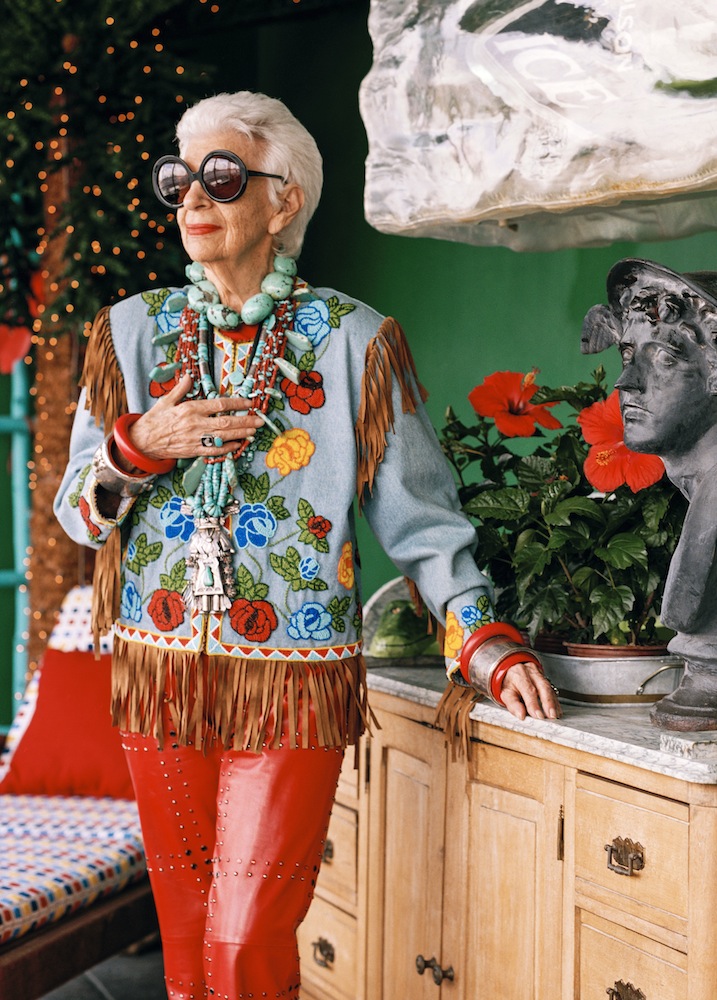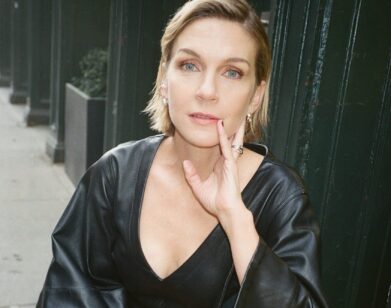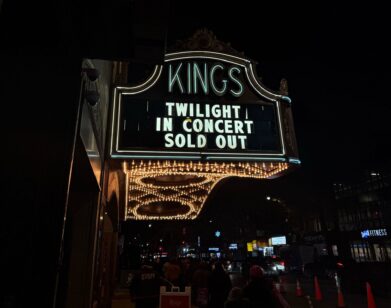Iris Apfel, Rare Bird

IRIS APFEL IN IRIS, A MAGNOLIA PICTURES RELEASE. PHOTO © BRUCE WEBER
In the 10 years since the Met’s Costume Institute exhibition “Rara Avis: Selections from the Iris Apfel Collection,” Iris Apfel, the Queens-born interior designer, has transitioned from an exuberantly dressed woman-about-town known by the fashion cognoscenti for flamboyantly mixing vintage Dior, 19th-century priest cassocks, flea market finds, and eye-popping jewels, into what she calls a “geriatric starlet.” She’s taken up the mantle of jewelry designer, Home Shopping Network personality, visiting professor at the University of Texas, and model for model for MAC, Kate Spade, and Alexis Bittar. She’s also served as a patron saint of free-spirited cool for everyone from Jenna Lyons to Kanye West (she even interviewed designer Peter Copping for this magazine back in 2012), all while doling out a droll bon mot or 10 in her New York accent and signature owlish glasses.
But Apfel gets the real star treatment as the subject of Iris, one of the final efforts of the late Grey Gardens and Gimme Shelter documentarian Albert Maysles, opening today. “I don’t have any rules because I would only be breaking them,” says Apfel in the film, and it astutely sums up her zestful take on her life and work. Maysles’ vérité-style approach captures Apfel in her element, whether managing her vast archive of couture costume jewelry at home (where she likes to dress her stuffed animal collection in various bits and baubles), bargain hunting in Harlem with Duro Olowu, styling window displays at Bergdorf Goodman with friend Linda Fargo, or spending time with her husband of almost 70 years, Carl, with whom she started the textile company Old World Weavers, which worked with the White House through several presidential administrations and took the couple on travels around the world.
Apfel, now 93, splits her time between her Upper East Side apartment and a home in Palm Beach, Florida, which is where Interview called her up by phone earlier this month.
COLLEEN KELSEY: I have to ask—when did you start wearing your big round glasses?
IRIS APFEL: As soon as I needed glasses, I thought, “If I was going to wear glasses, let me wear glasses!” I used to collect frames. I’ve been collecting accessories since I was 11-years-old, creeping around flea markets and sales and everything. Whenever I saw unusual eyeglass frames, I bought them. Occasionally, I would wear them just as an accessory without any lenses. So, when I had to wear them, I took out an old pair, and I put lenses in them. That’s what I’ve been doing. And people would always say to me, “Why are you wearing such large frames?” And I would say, “The bigger to see you.”
KELSEY: How did this film with Albert come about? When did you first meet?
APFEL: Well, he heard about me because of something I was doing, and he called. At first I refused because I thought, “Well, no. What does anybody need a documentary about me for? I have nothing to sell and no ego problems.” I didn’t want to do it. But then I spoke to several people including my good friend, Linda, and she said I must be crazy, that people would drop dead to work with Albert Maysles and, “He’s courting you, and you’re saying no. Who the hell do you think you are?”
Anyway, after thinking about it, he called again fortunately. I went up to his studio and met the staff, and we all fell in love. I had no idea what I was getting into. I’ve never done anything like it. I didn’t know anything about documentaries, but he promised that they would be very discreet and that they would not get in my hair and just follow. And that’s what we did. It went on and off for about four years because we were very rarely in the same place at the same time. He was in Europe a lot getting awards, and I was working and traveling, and I broke my hip and all that. But we finally ended up with enough film to make three more movies. I don’t know what went on the cutting room floor, but a lot of stuff. And of course, he didn’t work with any kind of script, so I had no idea what to expect. It was all done on blind sight. It was a wonderful experience because he was a great and talented gentleman. Everybody thinks we were old, old friends; we just hit it off. I never met him until the day we started to work together.
KELSEY: When did you realize that aesthetics and style was something you really responded to? Was it when you were growing up?
APFEL: Yes, yes, yes! I never did anything consciously; it just kind of happened. It seemed very normal.
KELSEY: Was there anyone whose style you particularly admired or idolized?
APFEL: There was Pauline de Rothschild, who I thought was very fabulous, and Millicent Rogers, the Standard Oil heiress, very chic, very clever, very original. I admired both those women very much. And I had a great example with my mother, who was extremely chic.
KELSEY: I know you studied art in college, but when did you transition more into interiors and interior design?
APFEL: I was in art school since I was five years old. I’ve always been to art school. Everything that’s happened to me, nothing’s been planned. I’ve never had a business plan. I just kind of fell into it, and I liked it, and I took a chance. I took a lot of chances in my life.
KELSEY: You’ve said before that you consider yourself “the world’s oldest teenager.” What keeps you in that teenage mindset?
APFEL: Well, I think I still keep my sense of wonder, which I call childlike, not childish, childlike. I still have a vivid imagination, and I like to try a lot of new things. The world is always full of promise. I guess maybe today, teenagers are not so open to things; they just press buttons. It’s not like when I was growing up, and I don’t feel like that anymore. I just never want to completely grow up.
KELSEY: What are you wearing today?
APFEL: Well, I just did a photo shoot, so I wore a quilted kind of patch jacket from Pakistan, and a lot of ethnic jewelry from all my travels, and threw it all together, which I love to do. So, I’m making a lot of noise as I walk.
KELSEY: I know you traveled quite a bit with Old World Weavers±what was your biggest place for inspiration?
APFEL: I never just went to look for clothes and style; I always find that wherever I go. But I like exotic, unusual places. Years ago, we used to love the Middle East and North Africa. I loved that with a passion. And of course, Italy and Paris. I love a lot of places for different reasons, but I love colors and sights and smells and things that are offbeat and different. The bazaars and the silks in the Middle East and North Africa were just spellbinding to me, a magnet.
KELSEY: I know you have such a big collection of clothing, accessories, furniture, everything, but how often do you go shopping now? Are you someone who’s always on the hunt?
APFEL: Very rarely. I mean, I go occasionally. Tomorrow maybe, I’ll go to a flea market. I don’t have much chance, but I don’t do normal shopping hardly at all. I’ve got so much stuff, I’m giving it away. Every once in a while, I like to, but there’s nothing really that talks to me nowadays. You know, years ago, everything was so new and unusual and different, and now, everything is same old, same old.
KELSEY: What designers’ work do you keep up with?
APFEL: Oh, I love Ralph Rucci, and there are a number of other designers. For runway, I think Naeem Khan is wonderful. There are so many designers that I really like. I mean, everyone does something that I like. I like the Italians; I think they have a lot of wit and charm. It’s hard to say. I don’t know too much about the younger ones.
KELSEY: What do you think about having so many fans, especially those of the younger generation? Is it a bizarre experience?
APFEL: Oh, I love it! I think it’s great. It’s very exciting. I’m amazed that I have fans. I mean, I cut across so many generations, and it’s male and female. I have a lot of male fans, not just fashionistas, but regular men. And of course, I don’t count myself as a fashionista because I do a lot of other things. That’s just a small part of my life, which happens to be celebrated in the film.
KELSEY: How do you define style?
APFEL: First, you have to know yourself and what you pull off, how much time you want to devote to it. You can’t just say, “I’m gonna have style.” You have to work at it. It’s intuitive; some people have it, and some people can work on it all day long, and it will never happen. And if you want to, it’s trial and error. You have to try different kinds of clothes and different kinds of makeup and see what works. You have to invest a little bit in it. If that’s all too much for you, and it doesn’t make you comfortable, then I think you should forget the whole thing. I think it’s better to be happy and comfortable than well dressed.
IRIS OPENS TODAY AT FILM FORUM AND FILM SOCIETY OF LINCOLN CENTER






